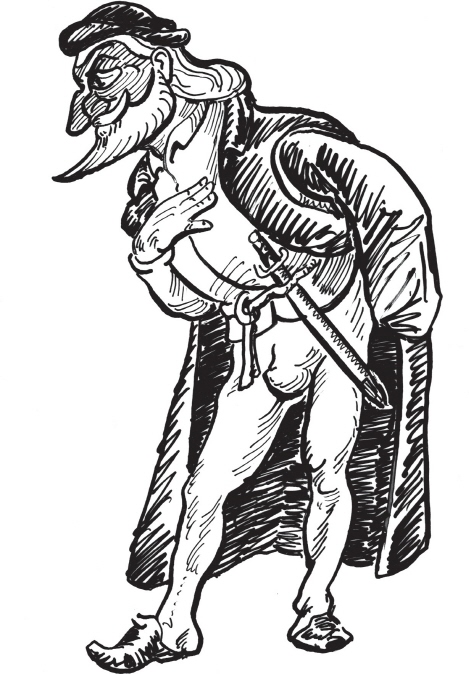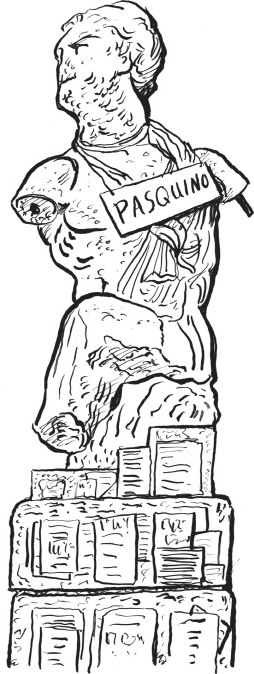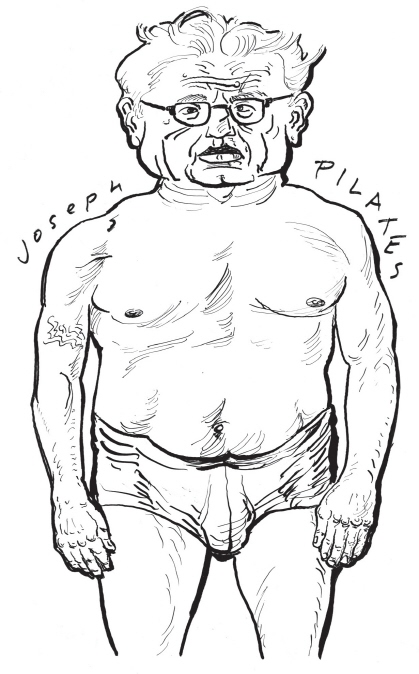Anonyponymous (8 page)
Authors: John Bemelmans Marciano

Since I have taken such pains to bring you together, let all pitiful
goers-between be called to the world’s end after my name,
call them all—Pandars!
pants
n. Pants.
Pantaleon was an unmarried physician living in the pagan Byzantine empire who, by simply invoking the name of Jesus Christ, could perform miraculous acts such as healing a blind man. Jealous, Pantaleon’s fellow doctors denounced him to the emperor, who, himself a patient of Pantaleon’s, asked the good doctor to give up this Christian nonsense—whereupon Pantaleon proved the power of God by curing a man of paralysis. Having witnessed the trick, the emperor condemned Pantaleon to death for the practice of black magic.
As is the case with many Catholic martyrs, death was the beginning of a second life. Pantaleon became the patron saint of physicians, bachelors, and torture victims, and now his own name could be invoked to cure a variety of ailments, as well as to guard against locusts. A member of the Fourteen Holy Helpers—a sort of league of super-saints who banded together to fight the Black Death— Saint Pantaleon’s stock went up dramatically in places like hard-hit Venice, where a spectacular church was dedicated to him in thanks for delivering the city from the plague. He later won even more ardent veneration in the Serenissima with the advent of the lottery and his designation as the heavenly provider of winning numbers. San Pantalone became so identified with the city in fact that his name was borrowed by the commedia dell’arte for the character of the prototypically greedy Venetian merchant.

The commedia dell’arte had storylines harking back to Roman times but was played out as improvisational farce. Each actor of the troupe dressed in mask and costume as one of a repertory of stock characters, such as Arlecchino, easily recognizable in his trademark diamond-patch outfit and better known to us by his Frenchified name, Harlequin. The costume signature of Pantalone was a pair of red leggings that reached the feet, a distinctively Venetian manner of cladding the legs that audiences outside the Veneto found odd and remarkable. Over the years and in various languages, the character’s name was borrowed to describe varying fashions of long trousers and related garments. This makes it hard to pin down exactly how and when American English adapted the anglicized name Pantaloon, but by the mid-1800s the term had comfortably been shortened to
pants.
Around this same time women first began wearing bloomers, which were advocated as an advancement in women’s freedom (quite literally, as it was seriously hard to move in those hoop skirts), most passionately by women’s rights and temperance activist Amelia Jenks Bloomer.
pa·pa·raz·zi
n. A member of the media who stalks
celebrities.
On his trip to Calabria in the winter of 1897–1898, English novelist George Gissing stopped for a few nights in Catanzaro, staying at the Baedeker-recommended Albergo Centrale. In his room he found a printed card addressed to guests.
“The proprietor,” Gissing later summarized the note, “had learnt with extreme regret that certain travellers who slept under his roof were in the habit of taking their meals at other places of entertainment. This practice, he desired it to be known, not only hurt his personal feelings—
tocca il suo morale
—but did harm to the reputation of his establishment. Assuring all and sundry that he would do his utmost to maintain a high standard of culinary excellence, the proprietor ended by begging his honourable clients that they would bestow their kind favours on the restaurant of the house . . . and therewith signed himself— Coriolano Paparazzo.”
Sixty years later a screenwriter in Rome was beset by a different problem. Ennio Flaiano was working with director Federico Fellini on a movie about international society and the nightlife of the Via Veneto. Their protagonist was a reporter who had an ever-present companion, a character based on the brazen new breed of photographer who made a living shooting stealth photos of celebrities on the town. The problem was what to call him. Flaiano desperately wanted the perfect name, a name that would make the character come alive. By chance, he opened up a new Italian translation of Gissing’s 1901 travel book
By the Ionian Sea
to a random page and saw the peculiar surname of the owner of the Albergo Centrale. “Paparazzo,” Flaiano wrote in his notes, “the name of the photographer will be ‘Paparazzo.’ ”
The movie,
La Dolce Vita
, was a smash success, and in its plural Italian form the word
paparazzi
has entered the world lexicon, giving old Coriolano a reputation he never expected. As Flaiano summed up, “Names have their destiny.”

pas·qui·nade
n. The public ridiculing of a person in written
verse or prose.
Piazza Navona was one of Rome’s most fashionable addresses long before the Via Veneto, and going way back was the site of the Stadium of Domitian, the field of which is traced in the piazza’s unusual oval shape. The badly damaged statue of a warrior thought to have decorated the Circus Agonalis (as the stadium was also known) came unearthed in 1501 when a street was dug up for the rebuilding of the Palazzo Orsini. Although such fragments were a dime a dozen in the Eternal City, the elderly cardinal overseeing the work was so charmed by the marble torso that he had it erected on the corner of the palazzo where it had been found.
Almost immediately, signs began appearing around the neck of the statue, who acquired the nickname Pasquino after maybe a tailor or barber who lived in the neighborhood. These nocturnally affixed placards contained bitingly sarcastic verses attacking the most powerful men of Rome, most often the ruling pope, at least one of whom tried to have Pasquino hurled into the Tiber. Not that it would’ve mattered, as statues all across the city had begun “talking,” a custom that continues to this day.
pi·la·tes
n. A very expensive form of exercise.
Life was tough growing up in 1880s Germany with a name like Pilates.
Pontius Pilate, Killer of Christ!
was the sort of taunt little Joseph Pilates had to put up with from kids in the school yard, made worse by the fact he was the classic sickly child, burdened with a plethora of diseases, both medieval (rickets, rheumatic fever) and modern (asthma). But Joseph turned it all around like the ninety-pound weakling in a Charles Atlas ad by throwing himself into bodybuilding, yoga, gymnastics, and boxing, coming up with his own system to strengthen and develop key muscles. Pilates came to America in the 1920s and soon opened a studio in New York. His “Contrology” method first caught on in the dance community, attracting such luminaries as Martha Graham and George Balanchine. It would take more than half a century, however, for Pilates to hit the mainstream (assuming, of course, that you consider status-conscious bougie housewives the mainstream). Once it did, the method became so popular that competing schools went to court over whether Pilates was a brand or
pilates
was a word.
A generic term for a product cannot be trademarked; in fact, a trademark can be invalidated if a product is so successful that its name
becomes
generic. This was enshrined into law when Judge Learned Hand stripped the German company Bayer of its exclusive right to the word aspirin, which it had trademarked in 1899. Brands whose parent companies have long had to fight against genericide are Coke, Kleenex, and Xerox, while nowadays Google works to stop the media from using
google
to mean doing an Internet search. Otherwise their brands might go the way of
zipper
, called “hookless fasteners” until B. F. Goodrich came out with Zipper galoshes in 1923;
heroin
, a morphine substitute trademarked by Bayer the year before it came out with aspirin (so-called because taking it made you feel like a hero); and
pilates
, which in 2000 was ruled by the courts to be free for anyone to use. At least, those of us who can afford it.
*

pom·pa·dour
n. A coiffure in which the hair is brushed
high off the forehead and turned back in a roll.
Jeanne Antoinette Poisson was a hot number around Paris in the 1740s, no matter that she was saddled with a kid and husband. Seeing her stock on the rise, Jeanne’s “uncle,” the powerful Le Normant de Tournehem, proposed her for the position of royal mistress, going behind the back of her husband, whose marriage to Jeanne de Tournehem had arranged in the first place. As hoped, Louis XV fell hard for her; in quick succession, the king bought Jeanne the estate of Pompadour, made her a marquise, and had her legally separated from her fuming husband. Louis also let her run the country’s foreign policy: She favored a shift in allegiance from the tiresome Prussians to the more stylish Hapsburgs, a move that resulted in the Seven Years’ War, a conflict which was, even by French standards, an utter disaster. (The days of Martinet were, sadly for the French, long gone.) Pompadour was blamed for the debacle and vilified but today is more fondly remembered as having bequeathed her name to a really silly fifties hairstyle.

pro·crus·te·an
adj. Ruthlessly forcing others to conform
to one’s own arbitrary standards.
Procrustes ran a hostelry on the side of an empty country road that led to Athens. A conscientious host, he made sure every guest fit his bed exactly; if they were too short for it, Procrustes would have them stretched out on the rack; if they were too tall, he’d lop off part of their legs. The thing was, the bed was adjustable, the game rigged. The Attic hero Theseus turned the tables on Procrustes when he put the criminal to his own bed and, finding him too long, lopped off both his feet and head, permanently closing Procrustes’s peculiar B&B.
pyg·ma·lion
n. A svengali without the malevolent
intentions.
A rather different mythological character from Procrustes was Pygmalion. According to Ovid, Pygmalion was a sculptor who carved for himself the ideal woman. His statue was so realistic that Pygmalion fell in love to the point of bringing her little gifts and putting a pillow under her head when he lay her down to bed. Pygmalion prayed to Venus for a wife like his ivory girl, and the goddess, understanding what the sculptor really wanted, transformed his creation into flesh and blessed the marriage.